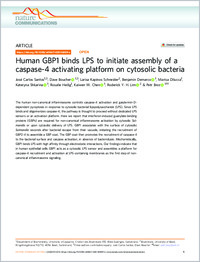Human GBP1 binds LPS to initiate assembly of a caspase-4 activating platform on cytosolic bacteria.
- Santos JC Department of Biochemistry, University of Lausanne, Chemin des Boveresses 155, 1066, Epalinges, Switzerland.
- Boucher D Department of Biochemistry, University of Lausanne, Chemin des Boveresses 155, 1066, Epalinges, Switzerland.
- Schneider LK Biozentrum, University of Basel, Klingelbergstrasse 50/70, 4056, Basel, Switzerland.
- Demarco B Department of Biochemistry, University of Lausanne, Chemin des Boveresses 155, 1066, Epalinges, Switzerland.
- Dilucca M Department of Biochemistry, University of Lausanne, Chemin des Boveresses 155, 1066, Epalinges, Switzerland.
- Shkarina K Department of Biochemistry, University of Lausanne, Chemin des Boveresses 155, 1066, Epalinges, Switzerland.
- Heilig R Department of Biochemistry, University of Lausanne, Chemin des Boveresses 155, 1066, Epalinges, Switzerland.
- Chen KW Department of Biochemistry, University of Lausanne, Chemin des Boveresses 155, 1066, Epalinges, Switzerland.
- Lim RYH Biozentrum, University of Basel, Klingelbergstrasse 50/70, 4056, Basel, Switzerland.
- Broz P Department of Biochemistry, University of Lausanne, Chemin des Boveresses 155, 1066, Epalinges, Switzerland. petr.broz@unil.ch.
- 2020-06-26
Published in:
- Nature communications. - 2020
Caspases, Initiator
Cell Line
Cytosol
Enzyme Activation
Epithelial Cells
GTP-Binding Proteins
HeLa Cells
Humans
Inflammasomes
Intracellular Signaling Peptides and Proteins
Lipopolysaccharides
Phosphate-Binding Proteins
Protein Binding
Pyroptosis
Salmonella
Static Electricity
English
The human non-canonical inflammasome controls caspase-4 activation and gasdermin-D-dependent pyroptosis in response to cytosolic bacterial lipopolysaccharide (LPS). Since LPS binds and oligomerizes caspase-4, the pathway is thought to proceed without dedicated LPS sensors or an activation platform. Here we report that interferon-induced guanylate-binding proteins (GBPs) are required for non-canonical inflammasome activation by cytosolic Salmonella or upon cytosolic delivery of LPS. GBP1 associates with the surface of cytosolic Salmonella seconds after bacterial escape from their vacuole, initiating the recruitment of GBP2-4 to assemble a GBP coat. The GBP coat then promotes the recruitment of caspase-4 to the bacterial surface and caspase activation, in absence of bacteriolysis. Mechanistically, GBP1 binds LPS with high affinity through electrostatic interactions. Our findings indicate that in human epithelial cells GBP1 acts as a cytosolic LPS sensor and assembles a platform for caspase-4 recruitment and activation at LPS-containing membranes as the first step of non-canonical inflammasome signaling.
- Language
-
- English
- Open access status
- gold
- Identifiers
-
- DOI 10.1038/s41467-020-16889-z
- PMID 32581219
- Persistent URL
- https://sonar.rero.ch/global/documents/165468
Statistics
Document views: 32
File downloads:
- fulltext.pdf: 0
